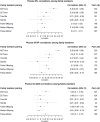Heritability of Alzheimer's disease plasma biomarkers: A nuclear twin family design
- PMID: 39588748
- PMCID: PMC11775461
- DOI: 10.1002/alz.14269
Heritability of Alzheimer's disease plasma biomarkers: A nuclear twin family design
Abstract
Introduction: Alzheimer's disease (AD) is a highly heritable disease (60%-80%). Amyloid beta (Aβ) 42/40, neurofilament light chain (NfL), and glial fibrillary acidic protein (GFAP) are plasma biomarkers for AD. Clinical biomarker research would be served by an understanding of the sources of variance in these markers.
Methods: Blood concentrations of Aβ42/40, NfL, and GFAP of twins and their families (monozygotic twins: 1574, dizygotic twins: 1266, other: 3657) were analyzed on the Simoa HD-X. Twin-family models were used to estimate proportional genetic contributions to the variance in biomarker levels.
Results: Heritability estimates were 16% for Aβ42/40, 42% for NfL, and 60% for GFAP. NfL and GFAP were significantly correlated with each other (0.37) but not with Aβ42/40.
Discussion: The heritability of Aβ42/40 (16%) is lower than the heritability of AD, suggesting strong environmental influences on this biomarker. The lack of correlation between NfL/GFAP and Aβ42/40 indicates these markers may be on different biological pathways.
Highlights: Heritability is found for glial fibrillary acidic protein (60%), neurofilament light chain (42%), and amyloid beta (Aβ) 42/40 (16%) plasma levels. Aβ42/40 plasma levels are sensitive to person-specific environmental influences.
Keywords: Alzheimer's disease; amyloid beta 42/40 ratio; glial fibrillary acidic protein; heritability; neurofilament light chain; twin study.
© 2024 The Author(s). Alzheimer's & Dementia published by Wiley Periodicals LLC on behalf of Alzheimer's Association.
Conflict of interest statement
CET has research contracts with Acumen, ADx Neurosciences, AC‐Immune, Alamar, Aribio, Axon Neurosciences, Beckman‐Coulter, BioConnect, Bioorchestra, Brainstorm Therapeutics, Celgene, Cognition Therapeutics, EIP Pharma, Eisai, Eli Lilly, Fujirebio, Instant Nano Biosensors, Novo Nordisk, Olink, PeopleBio, Quanterix, Roche, Toyama, Vivoryon. She is editor in chief of
Figures




References
-
- Association As . 2022 Alzheimer's disease facts and figures . Alzheimers Dement. 2022;18(4):700‐789. - PubMed
-
- Organization WH . Global Health Estimates 2020: Deaths by Cause, Age, Sex, by Country and by Region, 2000‐2019. WHO; 2020. https://www.who.int/data/gho/data/themes/mortality‐and‐global‐health‐est...
-
- Amieva H, Jacqmin‐Gadda H, Orgogozo J‐M, et al. The 9 year cognitive decline before dementia of the Alzheimer type: a prospective population‐based study. Brain. 2005;128(5):1093‐1101. - PubMed
-
- Pegueroles J, Vilaplana E, Montal V, et al. Longitudinal brain structural changes in preclinical Alzheimer's disease. Alzheimers Dement. 2017;13(5):499‐509. - PubMed
Publication types
MeSH terms
Substances
Grants and funding
- 904-61-090/Netherlands Organization for Scientific Research
- 985-10-002/Netherlands Organization for Scientific Research
- 904-61-193/Netherlands Organization for Scientific Research
- 480-04-004/Netherlands Organization for Scientific Research
- 400-05-717/Netherlands Organization for Scientific Research
- Addiction-31160008/Netherlands Organization for Scientific Research
- 016-115-035/Netherlands Organization for Scientific Research
- 400-07-080/Netherlands Organization for Scientific Research
- NWO-Groot 480-15-001/674/Netherlands Organization for Scientific Research
- Middelgroot-911-09-032/Netherlands Organisation for Health Research and Development
- 73305095007/Netherlands Organisation for Health Research and Development
- 10510032120003/Netherlands Organisation for Health Research and Development
- 01254/European Commission
- 01413/GenomEUtwin
- Alzheimer Drug Discovery Foundation
- JPND
- National Multiple Sclerosis Society
- LSHM20106/Health Holland, Topsector Life Sciences & Health
- The Selfridges Group Foundation
- Alzheimer Netherlands
- ALZ/Alzheimer's Association/United States
LinkOut - more resources
Full Text Sources
Medical
Research Materials
Miscellaneous

